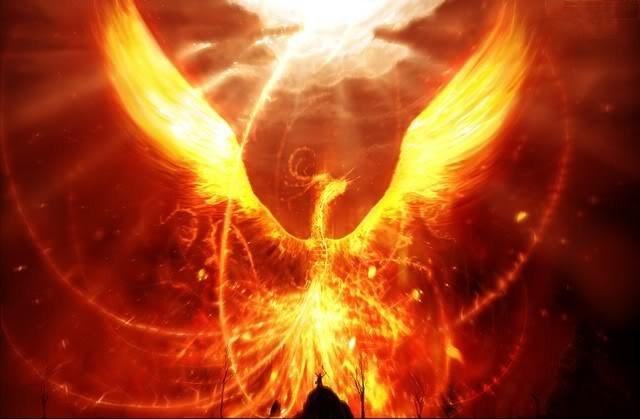A bobbin, vortex, whirling gyre,
The tongues ascend, a silent choir,
A phoenix trope for pure desire.
The painter sees as flames aspire
The anagram of Frye is Fyre.
As for the theft of fire, many of the stories put the source of fire in the under world, where the sun is at night, so that when the thief of fire returns he is also the rising sun. [Notebook 7.22]
There’s the Paravritti, the Beulah-Eden vortex through the ray of fire which opens out into the mystic rose. [Notebook 7.33]
Engineering metaphors or thought models start of course with fire and the wheel. One gives metaphors of spark, scintilla, energy & the like: most of our organism metaphors take off from it. [Notebook 18.10]
In the Great Doodle (apocalyptic) the spiritual world is (a) the fire-world of heavenly bodies (b) the lower heaven or sky. Hence it is normally (a) red with the seraphim (b) blue with the cherubim. Blue & white mean virginity, red & white love; red white & green is the point of epiphany. [Notebook 18.98]
Whenever Eros got into the Xn trdn. [Christian tradition] (Inge has it in his book on mysticism) Eros (not Cupid) is certainly a Gentile type of Christ, and Prometheus of the Spirit. Fire seems right; it’s what the gyre kindles. Try to think about Abraham’s furnace; fire descending to the altar (less Elijah than Chronicles), the three “children” (magi?) in Nebuchadnezzar’s furnace [Daniel 3]. Blake certainly thought Los’s furnaces had something. Smart on Abraham’s. Speaking of magi, they should have been women, as they’re antitypes of the Queen of Sheba’s visit to Solomon. [Notebook 27.147]
Man is asleep and fantasizing in the ladder, garden and seed worlds. His central activity there is quest, the projection of Word into Deed that enables him to go on sleeping. In the fire world he’s compelled to wake up, hence the first thing he does is withdraw the quest. [Notebook 27.188]
What the released flame of Prometheus illuminates is, among other things, the true ladder as the four phases of meaning. The flame, by the way, has to include the occult link between the living fire & the warm-blooded organism I mentioned in GC [The Great Code, 161-2]. [Notebook 27.190]
The fire-chapter should include, first of all, Little Gidding and the two Byzantium poems. SB [Sailing to Byzantium] is a panoramic apocalypse: every state of the chain of being appears on fire as nature is destroyed & the artifice of eternity replaces it. Byzantium burns from the inside. Note how intensely Heraclitean both Eliot & Yeats get when they enter the fire. [Notebook 27.250]
What’s the Biblical setup? I think it’s polarized between the first coming of Christ in water and his second coming in fire. [Notebook 27.259]
To go from the ladder-garden world to the ark-flame one, think of going from Ash-Wednesday to the Quartets, from The Tower to A Vision (if only Yeats had got the vision!). Note that I was first attracted to archetypal criticism by Colin Still’s book on The Tempest, with its central conception of the ladder of elements, a conception going back to the pre-Socratics. Heraclitus says there’s an exchange of “fire” and of “all things,” as there is of “gold” for “wares.” That’s something to chew on. [Notebook 27.263]
